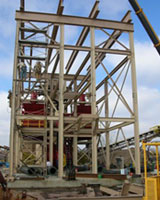Structural Fabrication Jobs
People who work on structural fabrication jobs are involved in designing and building towers, tunnels, bridges and other buildings. They will also assist in analyzing the capabilities of structures meant to resist or support loads, such as columns, beams and floors. Engineering companies that employ structural fabricators will work closely with these metal manipulation specialists to ensure the created products meet all design, safety and performance criteria. It is imperative that buildings will not bend or collapse.
The Specific Roles of Workers on Structural Fabrication Jobs
Fabricators working on structural fabrication jobs will prepare metal structures according to the detailer's drawings. These drawings are based on the actual construction blueprints provided by a structural engineer. The final product will depend on the available fittings and materials. There are many different drawings that workers on structural fabrication jobs are expected to read and understand.
Structural Fabrication Jobs and Drawings
Design drawings for structural fabrication jobs are made by architects or engineers. These drawings show all the necessary details of structural drawings. Data provided by these drawings include axial forces, loads, moments and forces. In addition, precise dimensions framing members, general reference notes and beam/column locations will be included.
Another drawing used for structural fabrication jobs are anchor bolt plans. These plans explain anchor bolt settings in relation to footings and foundations. Usually, the foundation is not related to the tasks completed by structural fabricators; however, there may be a list of items that the fabricator is required to supply. Some items supplied by structural fabricators include anchor bolts, grilles, leveling base plates and machinery braces. Once the masonry expert is ready for the fabricator to supply the last anchor bolt plans, the fabricator will explain the configuration of the bolts' field placement.
Column base details are another integral drawing on structural fabrication jobs. These drawings illustrate how the columns connect to the foundation and the frame. Other information included may be in regards to anchor bolt projection, base plate elevation and grout thickness dimensions. There are also detailed drawings that show all connection details. These drawings explain how the structural members connect to one another and may show clearance and assembly dimensions. From these drawings, steel shop drawings are created.
Shop drawings are used in structural fabrication jobs to show workers how each member is to be made. The dimensions and details listed in the details drawings will instruct the manufacturers. While drawing standards may vary, the majority of drawings for U.S. purposes follow structural detailing standards set by the American Institute of Steel Construction, or AISC.
Erection plans are also a part of structure building. Steel framing sub-assembly, anchor bolt plans and column base connections are included in erection plans. The Bill of Materials, or BoM, is the final drawing used in structural fabrication jobs. Usually, a drafter skilled in Computer Aided Drafting, or CAD, will form a bill of materials that lists each structural member of the building. The BoM is show at the top of every shop drawing and will display useful information like connection plate sizes, erection marks, field fasteners and material quantities.

